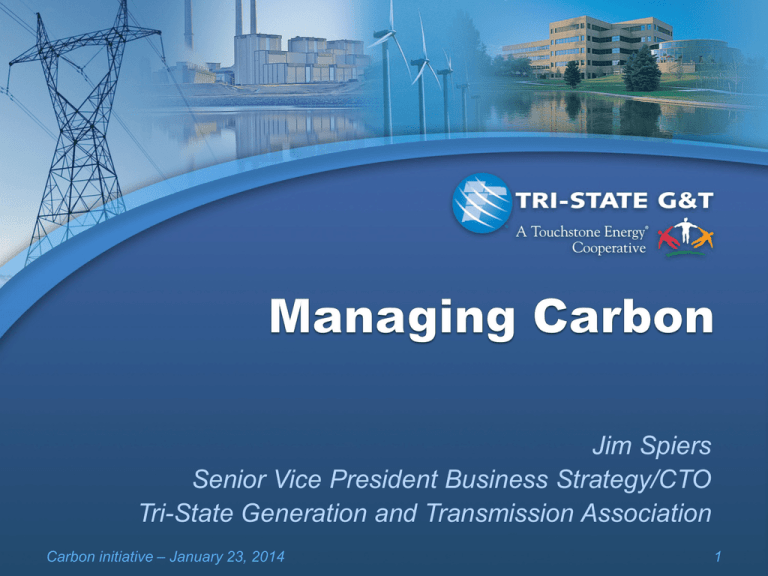Jim Spiers Senior Vice President Business Strategy/CTO Tri
advertisement

Jim Spiers Senior Vice President Business Strategy/CTO Tri-State Generation and Transmission Association Carbon initiative – January 23, 2014 1 Tri-State Generation and Transmission Association Consumer-owned, notfor-profit wholesale power supplier owned by 44 electric co-ops and public power districts Through its members, serves approximately 1.5 million people across 200,000 square miles Carbon initiative – January 23, 2014 2 Fundamentally, utilities manage risk for their consumers The utility industry excels at aggregating and managing the risks of providing power Operational Market Financial Regulatory Carbon initiative – January 23, 2014 3 Fundamentally, utilities manage risk for their consumers Carbon management is a unique risk Policies are evolving Technologies are evolving Carbon affects all aspects of utility other industries Carbon initiative – January 23, 2014 4 Fuel switching? Introduces new risks Operational Market Financial Abandonment of significant capital investment Modern production fleet w/ advanced emissions controls Carbon initiative – January 23, 2014 5 Carbon capture and sequestration Technology incrementally advancing Enhanced oil recovery a demonstrated option However, significant economic and regulatory uncertainty Is it wise for us to place only one bet? Carbon initiative – January 23, 2014 6 Technology options help manage risk Current carbon management technologies are being incrementally advanced Challenges require radical advancement on new technology How Do We Foster Innovation? Carbon initiative – January 23, 2014 7 To go beyond incremental advancement, think of carbon as an asset Carbon initiative – January 23, 2014 8 Why not use carbon? Carbon initiative – January 23, 2014 9 Research indicates potential 136 (and counting) Carbon Recycling Entities Carbon initiative – January 23, 2014 >90 Emerging Carbon Capture Approaches 10 Carbon capture innovation: Six different categories Solvents Enzyme Based Systems Physical Sorbents Precipitated Calcium Carbonate Ionic Liquids Gas Separation Membranes Metal Organic Frameworks (MOFs) Carbon initiative – January 23, 2014 11 Carbon utilization innovation: Three major categories Biological A biological organism rapidly absorbs CO2 to produce a product Chemical/catalytic A catalyst breaks the carbon-oxygen bond, then combines the carbon with other elements to produce a product Mineralization CO2 is locked into solid structures that can then be incorporated into products Carbon initiative – January 23, 2014 12 There is great potential to advance carbon capture and utilization, but… These technologies are nascent! Small scale / laboratory Expensive Unproven How Do We Spur Their Commercialization? Carbon initiative – January 23, 2014 13 Commercializing the CO2 asset industry Carbon initiative – January 23, 2014 14 Problem statement: Need real world technologies Laboratory conditions don’t mimic the real world operating environment Innovators find it difficult to test their technologies in the real world because of utilities’ “stack risk” Laboratories don’t reflect the real world Carbon initiative – January 23, 2014 “Stack risk” prevents real world deployments 15 Research indicates unmet need Multiple “Integrated” Platforms Single Platform Single Technology Carbon initiative – January 23, 2014 Multiple Technologies Tri-State’s syndicated research on test centers shows a need and value for energy test facilities that support multiple technologies on multiple integrated platforms 16 Creating real world technology One location facilitates testing at various scales Accelerate technologies into the real world Advance the future needs of the electric industry Mitigate selection risk by providing research and testing platforms in numerous areas An end-to-end carbon utilization center is the cornerstone. Carbon initiative – January 23, 2014 17 Leveraging precedent-NCCC The U.S. governmentfunded National Carbon Capture Center (NCCC) is a proven technology accelerator Focused mostly on conventional carbon capture Carbon initiative – January 23, 2014 Progress at the NCCC will be leveraged by the new test center 18 Leveraging precedent-PC4 The Post-Combustion Carbon Capture Center (PC4) within the NCCC Provides access to coal- combustion flue gas streams for testing of post-combustion carbon capture technologies CO2 capture at NCCC complemented by the new test center’s utilization approaches Carbon initiative – January 23, 2014 The PC4 tests carbon capture technologies within the NCCC 19 Integrated Energy Test Center ____________________ GENERATION STATION Carbon initiative – January 23, 2014 20 Technology commercialization platform: >20 Institutions University of Wyoming Wyoming Community Colleges Potential Role? Carbon initiative – January 23, 2014 21 Igniting the industry “Once talent has been identified, it has to be focused in the desired direction and ignited…” Carbon initiative – January 23, 2014 22 Prizes can spark an industry 2010 1992 1791 Progressive Automotive X PRIZE Chemical Engineering Prize French Academy The Golden Carrot Prize 1714 2004 1927 The Longitude Act of 1714 The Orteig Prize (Charles Lindbergh) Carbon initiative – January 23, 2014 The Ansari X PRIZE 23 XPRIZE Takes Prizes Further 26 Teams from 7 Nations Spent >$100 million to win Launched a new, personal spaceflight industry Drove regulatory reform Received >12 billion media impressions worth >$200 million Carbon initiative – January 23, 2014 24 XPRIZEs create leverage Highly leveraged: Typically 10 – 40x Efficient: Only pays the winner Can spark new industry and market development $1B+ Industry start $100M Teams’ spend $10M - Purse $2.5M – Start-up Ansari Family St. Louis Carbon initiative – January 23, 2014 25 Under development: The Carbon XPRIZE Could be first “tenant” of the new test center $10 million prize, advanced market commitment & benefits Turn CO2 from a liability to an asset Carbon initiative – January 23, 2014 26 Tri-State has made significant effort to advance carbon utilization 2010: Seeded multiple development efforts, including syndicated research 2011: Sponsored formal prize development process and IP creation 2012: Sponsored coalition building and stakeholder outreach efforts 2013: Tri-State and Canadian energy interests jointly pursuing initiative Carbon initiative – January 23, 2014 27 In conclusion Focus on radical technology advancement in capture and utilization Spur early stage technologies Inspire innovators and spark new industries through inducement prize Create options for industry to manage carbon risk at utility scale Demonstrate and scale up emerging technologies at integrated test center Carbon initiative – January 23, 2014 28 Cornerstone: CO2 Utilization Center Unconventional carbon capture + beneficial utilization technologies Breakthrough the current capital and parasitic load burdens The World’s First End-to-End Carbon Solution Accelerator Carbon initiative – January 23, 2014 29 Carbon initiative – January 23, 2014 30
